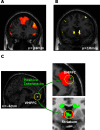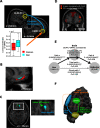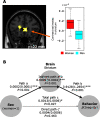Functional Connectivity Basis and Underlying Cognitive Mechanisms for Gender Differences in Guilt Aversion
- PMID: 34819311
- PMCID: PMC8675089
- DOI: 10.1523/ENEURO.0226-21.2021
Functional Connectivity Basis and Underlying Cognitive Mechanisms for Gender Differences in Guilt Aversion
Abstract
Prosocial behavior is pivotal to our society. Guilt aversion, which describes the tendency to reduce the discrepancy between a partner's expectation and his/her actual outcome, drives human prosocial behavior as does well-known inequity aversion. Although women are reported to be more inequity averse than men, gender differences in guilt aversion remain unexplored. Here, we conducted a functional magnetic resonance imaging (fMRI) study (n = 52) and a large-scale online behavioral study (n = 4723) of a trust game designed to investigate guilt and inequity aversions. The fMRI study demonstrated that men exhibited stronger guilt aversion and recruited right dorsolateral prefrontal cortex (DLPFC)-ventromedial PFC (VMPFC) connectivity more for guilt aversion than women, while VMPFC-dorsal medial PFC (DMPFC) connectivity was commonly used in both genders. Furthermore, our regression analysis of the online behavioral data collected with Big Five and demographic factors replicated the gender differences and revealed that Big Five Conscientiousness (rule-based decision) correlated with guilt aversion only in men, but Agreeableness (empathetic consideration) correlated with guilt aversion in both genders. Thus, this study suggests that gender differences in prosocial behavior are heterogeneous depending on underlying motives in the brain and that the consideration of social norms plays a key role in the stronger guilt aversion in men.
Keywords: DLPFC; fMRI; gender difference; guilt aversion; prosocial behavior; social norm.
Copyright © 2021 Nihonsugi et al.
Figures





Similar articles
-
Gender differences in guilt aversion in Korea and the United Kingdom.Sci Rep. 2022 May 17;12(1):8187. doi: 10.1038/s41598-022-12163-y. Sci Rep. 2022. PMID: 35581333 Free PMC article.
-
Neural Mechanisms Underlying Individual Differences in Control-Averse Behavior.J Neurosci. 2018 May 30;38(22):5196-5208. doi: 10.1523/JNEUROSCI.0047-18.2018. Epub 2018 May 14. J Neurosci. 2018. PMID: 29760183 Free PMC article.
-
Triangulating the neural, psychological, and economic bases of guilt aversion.Neuron. 2011 May 12;70(3):560-72. doi: 10.1016/j.neuron.2011.02.056. Neuron. 2011. PMID: 21555080 Free PMC article.
-
The role of the anterior insula in social norm compliance and enforcement: Evidence from coordinate-based and functional connectivity meta-analyses.Neurosci Biobehav Rev. 2018 Sep;92:378-389. doi: 10.1016/j.neubiorev.2018.06.024. Epub 2018 Jun 26. Neurosci Biobehav Rev. 2018. PMID: 29958872 Review.
-
[Decision-making and schizophrenia].Encephale. 2011 Dec;37 Suppl 2:S110-6. doi: 10.1016/S0013-7006(11)70036-7. Encephale. 2011. PMID: 22212839 Review. French.
Cited by
-
Gender differences in guilt aversion in Korea and the United Kingdom.Sci Rep. 2022 May 17;12(1):8187. doi: 10.1038/s41598-022-12163-y. Sci Rep. 2022. PMID: 35581333 Free PMC article.
-
The Neural Signatures of Shame, Embarrassment, and Guilt: A Voxel-Based Meta-Analysis on Functional Neuroimaging Studies.Brain Sci. 2023 Mar 26;13(4):559. doi: 10.3390/brainsci13040559. Brain Sci. 2023. PMID: 37190524 Free PMC article. Review.
References
-
- Andreoni J, Vesterlund L (2001) Which is the fair sex? Gender differences in altruism. Q J Econ 116:293–312. 10.1162/003355301556419 - DOI
-
- Balafoutas L, Fornwagner H (2017) The limits of guilt. J Econ Sci Assoc 3:137–148. 10.1007/s40881-017-0043-0 - DOI
-
- Baron-Cohen S (2004) The essential difference: men, women and the extreme male brain. London: Penguin.
Publication types
MeSH terms
LinkOut - more resources
Full Text Sources
Medical
Miscellaneous
